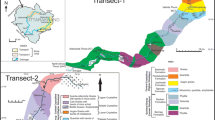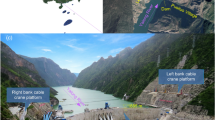Abstract
The deformation modulus of intact rock can be determined through standardized laboratory tests for heavily jointed rock masses but this is very difficult, while in situ tests are time-consuming and expensive. In this study, the deformation modulus of selected heavily jointed, sheared and/or blocky, weathered, weak greywacke, andesite and claystone were assessed, based on pressuremeter tests, geo-engineering characterization and seismic surveys. Empirical equations based on GSI and RMR values are proposed to indirectly estimate the deformation modulus of the greywackes. For the andesites, the spacing of the discontinuities is greater than the length of the pressuremeter probe hence the intact rather than rock mass deformation modulus is obtained. The pressuremeter test results from the claystones could not be correlated with the field data; the relationship between the ratio of rock mass modulus to intact rock modulus and RQD appears to give a better estimation of the deformation modulus.
Résumé
Le module de déformation de roches intactes peut être déterminé à partir d’essais de laboratoire normalisés. Ces essais peuvent difficilement donner les paramètres de déformabilité de masses rocheuses intensément fracturées. Par ailleurs les essais en place sont longs et coûteux. Dans cette étude, les modules de déformation ont été évalués pour des grauwackes, des andésites et des argilites intensément fracturés ou altérés, en utilisant l’essai pressiométrique, des classifications géotechniques et des résultats de prospections sismiques. Des équations empiriques basées sur les indices GSI et RMR sont proposées afin d’estimer les modules de déformation de grauwackes. Pour les andésites testées, l’espacement des discontinuités est plus grand que la longueur de la sonde pressiométrique. De ce fait, c’est plus le module de déformation de la matrice rocheuse qui est obtenu, plutôt que celui du massif rocheux. Les résultats des essais pressiométriques relatifs aux argilites n’ont pu être corrélés avec des données de terrain. La relation entre d’une part le rapport module du massif rocheux sur module de la matrice rocheuse et d’autre part l’indice RQD apparaît plus adaptée pour donner une bonne estimation du module de déformation.












Similar content being viewed by others
References
Akyurek B, Bilginer E, Akbas B, Hepsen N, Pehlivan S, Sunu O, Soysal Y, Dager Z, Catal E. Sozeri B, Yildirim H, Hakyemez Y (1984) Geological features of Ankara-Elmadag-Kalecik and vicinity. Jeoloji Muhendisliği 20: 31–46 (in Turkish)
ASTM (2000) Standard test method for pressuremeter testing in soils: annual book of ASTM Standards. ASTM Publications, Philadelphia
Barton N (2007) Rock quality, seismic velocity, attenuation and anisotropy. Taylor & Francis, London, 729 p
Bieniawski ZT (1978) Determining rock mass deformability: experience from case histories. Int J Rock Mech Min Sci 15:237–247
Bieniawski ZT (1989) Engineering rock mass classifications. Wiley, New York, p 237
Centre D’Etudes Ménard (1975) Interpretation and application of pressuremeter test results to foundation design. Sols-soils no 26, 44 p
Deere DU, Miller RP (1966) Engineering classification and index properties for intact rock. Technical report no. AFNL-TR-65-116. Air Force Weapons Laboratory, New Mexico
Erol O (1956) An investigation on geology and geomorphology of Elmadagi and its vicinity at southwest of Ankara. Publication of MTA, no. 9 (in Turkish)
Goodman RE (1989) Introduction to rock mechanics. Wiley, New York, 562 p
Hagedoom JG (1965) The plus–minus method of interpreting seismic refraction sections. Geophys Prospect 7:158–182
Hoek E (1999) Putting numbers to geology—an engineer’s view point. Q J Eng Geol 32:1–19
Hoek E, Brown ET (1997) Practical estimates of rock mass strength. Int J Rock Mech Min Sci 34(8):1165–1186
ISRM (2007) The complete ISRM suggested methods for rock characterization, testing and monitoring. In: Ulusay R, Hudson JA (eds) Compilation arranged by the ISRM Turkish National Group, Kozan Ofset, Ankara, Turkey, 628 p
Kulhawy FH (1975) Stress deformation properties of rock and rock discontinuities. Eng Geol 9(4):327–350
Lamé G (1852) Leçons sur la théorie mathématique de l’élasticité des corps solides. Bachelier, Paris
Mair RJ, Wood DM (1987) Pressuremeter testing. Ciria Butterworths, London, 160 p
Ménard L (1961) Influence de l’amplitude et de l’histoire d’un champ de contraintes sur le tassement d’un sol de foundation. C. R. 5 e Congrés International MSTF, Tome 1, Paris
Nurlu YE (1996) Determination–classification and mapping of the degree of weathering in Ankara greywackes. M.Sc. thesis, Hacettepe University, Department of Geological Engineering (in Turkish)
Orhan M, Isik NS, Topal T, Ozer M (2006) Effect of weathering on the geomechanical properties of andesite, Ankara, Turkey. Env Geol 50(1):85–100
Ozilcan S (2004) Geoengineering properties of the grounds at the western part of Ankara. M.Sc. thesis, Hacettepe University, Department of Geological Engineering (in Turkish)
Palmström A, Singh R (2001) The deformation modulus of rock masses—comparisons between in situ tests and indirect estimates. Tunn Undergr Space Technol 16:115–131
Sonmez H, Ulusay R (1999) Modifications to the geological strength index (GSI) and their applicability to stability of slopes. Int J Rock Mech Min Sci 36(6):219–233
Sonmez H, Ulusay R (2002) A discussion on the Hoek–Brown failure criterion and suggested modifications to the criterion verified by slope stability case studies. Yerbilimleri 26:77–99
Sonmez H, Gurkan B, Sonmez B (2008). Engineering characteristics of Ankara greywacke under the foundation of the Beytepe open air theatre, Ankara, Turkey. Environmental Geology (in press, DOI 10.1007/s00254-007-0994-1)
Stacey TR (1977) Seismic assessment of rock masses. Symposium on exploration for rock engineering. Johannsburg 2:113–117
Stapledon DH, Rissler P (1983) Site exploration and evaluation. Proceedings of the 5th international congress on rock mechanics. Melbourne 3:G5–G25
Ulusay R, Gokceoglu C, Sulukcu S (2001) Draft ISRM suggested method for determining block punch strength index (BPI). Int J Rock Mech Min Sci 38:1113–1119
Zhang L, Einstein H (2004) Using RQD to estimate the deformation modulus of rock masses. Int J Rock Mech Min Sci 41:337–341
Author information
Authors and Affiliations
Corresponding author
Rights and permissions
About this article
Cite this article
Isik, N.S., Doyuran, V. & Ulusay, R. Assessment of deformation modulus of weak rock masses from pressuremeter tests and seismic surveys. Bull Eng Geol Environ 67, 293–304 (2008). https://doi.org/10.1007/s10064-008-0163-0
Received:
Accepted:
Published:
Issue Date:
DOI: https://doi.org/10.1007/s10064-008-0163-0




